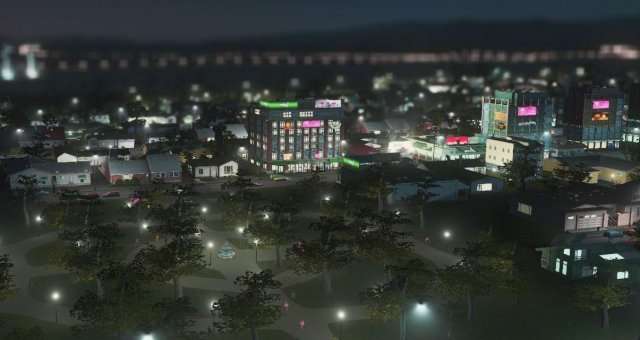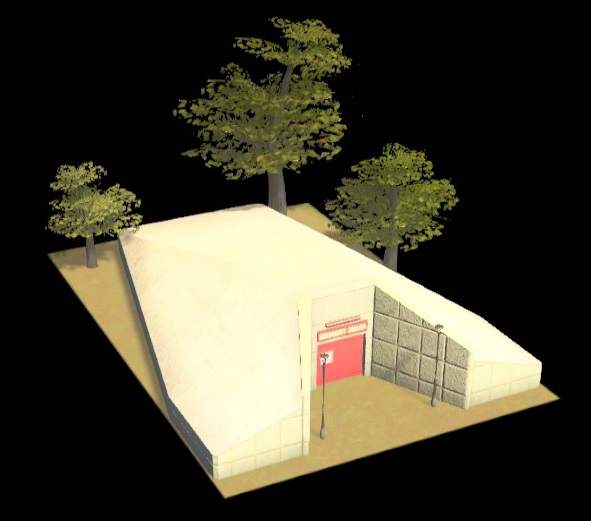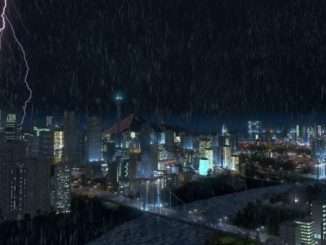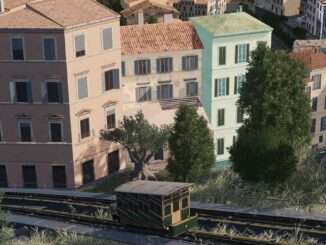
Want to know how to use Shelters? This guide tells you everything you want to know about Bunkers and their usage in game to keep your population safe.
Bunkers: Basics and Upkeep
A small shelter, Large shelter and a Doomsday Vault next to each other.
Basics and Upkeep
City skylines Disasters DLC includes shelters to protect your cities population from demise when disaster strikes. They require 3 things to store to function once disaster strikes. These are Water, Power and Food. despite popular belief, the food CAN NOT be obtained from farm zoned industries but instead they are found to come from generic factories that dispatch generic commercial goods. In the DLC there are two kinds of bunkers. These bunkers and character traits are…

Small Shelters
- Cost 24,000
- Upkeep 480
- Size 2×3
- Capacity 1000 – 1300 buffed
- Evacuation Bus count 5 – 7 at 150% funding
Large Shelter
- Cost 74000
- Upkeep 1600
- Size 4×10
- Capacity 10000 – 13000 buffed
- Evacuation Bus count 10 – 13 at 150% Funding
Note: that this shelter has a road leading into its structure.
Note: The +30% storage buff is applied to every shelter after the Doomsday Vault is constucted.
Evacuation and Evacuation Routes
Radio Towers
Before the population can evacuate towards a Shelter, Radio towers must be installed in the city to allow the population to know that they need to leave their homes. Radio towers come in two sizes, small and large. Small radio towers are used for remote settlements and large radio towers will be predominantly used in the city. Although Radio towers cover a large area, terrain can block signals. Make sure your towers are on top of mountains or make a small raised hill of a plateau.
Evacuation of facilities
Only Residential can be evacuated. If someone is at work and the evacuation begins, they will return home first then go to the shelter that is close to their home. Evacuation Shelters do not work in industrial or commercial zones (Applies to Campus or Industries areas.) If an evacuation is in effect, nearby stadiums and Airports will close down and if you have a rocket in construction the launch will be cancelled. Tourists will either go to another attraction in the city or leave by driving.
Experiment to see if industry and comercial zones flee.
Evacuation of Homes
When the evacuation begins, people will immediately start leaving their homes, when this occures they choose a method of transportation to head to the shelter, these are…
- Walk
- Bike ride
- Drive
- Shelter Bus
Note: Public transport will not be used so a metro to the shelter will be pointless.
Walk/Bike
People walking and bike riding will always travel the fastest path to the shelter, they will cut through parks (including parks with gates made with the Parklife DLC) foot paths and if on a bike use bike paths. The more footpaths cut through roads the faster and more likely the Citizens will arrive to the shelter on time and less traffic time due to people walking more and sticking to a footpath rather than walking and crossing roads.
Looking closely is an example of how footpaths, roads and bus lines relate to shelters.
Cars
The further away the People live from the closes Shelter the more likely they will drive. When this happens in low density, small suburbs its controllable but in high density or large suburbs this can cause congestion and cause traffic to come to a stand still. Cars should be the last resort, not the first option. If you cant put footpaths in or parks. Change streets to include bikes.
Evacuation Busses
Evacuation busses work best with one or two stops, three would be max.
Evacuation busses work similar to regular busses but only are deployed in an evacuation. These busses are best used when gathering the people who live on the brim of the Shelter range to reduce the cars on the road and help get larger numbers to the shelter. Although busses are useful they have some flaws about their route. If they get a full load of passengers they will continue to stop at the other destinations along the way even though they are full. Ways you can counter this is to make the bus stop near the bunker then go to the second destination or have the busses stop by remote places to stop the general public prioritising that emergency transit. Evacuation busses can use bus lanes so keep this in mind when designing routes.
Evacuation bus route to a distant neighbourhood.
Placement and Management
Small Or Large Shelter
Which is better? Is a Hammer better than a Nail Gun? Or are wedges better than flats? They both excel in their own areas. The small shelter is 1/3 the cost and upkeep of the large shelter and thus you can place 3 shelters down. You may think “why would i pay the same for something that gives 3000 compared to something that gives me 10000?” The reason is 2 things. Size, and access points. Just like a carton of milk, you can get more volume through 3 holes than one hole that has a bigger bottle. 3 shelters has the capacity to cover the same area more efficiently due to people not having to travel as far to a safe place. Small shelters can fit on the side of the road like any other low density structure so your not taking up usable building space.
Large structures are perfect for nearby high density structures as they can take the demand of the flooding population and due to the road entering the structure it can funnel cars in efficiently. They do take up more space so planning needs to be taken into consideration before placing them and if placed in the middle of a road it will create an intersection. By placing the Large shelter on the edge of the road and changing the road to a decorative grass or tree one lane road it can remove the pedestrian crossing. Making pedestrians more likely to seek another crossing else where.
Management
Want to control the population from running to a shelter across the map when there is one next to where they live? Here is some ways you can control them and gather information on the area.
First
Use the district tool and paint the area that the suburb is located. Make it neat so you can have other districts surrounding it nicely.
Second
Double check the population within the district by clicking on the district name.if there is a high population you may be required to build more Shelters or if its small it may be better to downsize or remove a few shelters. Relating to the image the population is over 3000 so 4 small shelters will mean everyone will be protected in an emergency if they make it on time.

The population can be seen near the top Pie graph to the top right.
Third
Select the box policies on the district info box. Once opened click the VIP area. This will stop the population running to other shelters outside the district and it will keep out others from using that districts shelters.
Note: If there was a policy like this for cemeteries and crematoriums, death waves would cease to be an issue due to them picking up bodies in their own district rather than running across the city.
Detection Structures
Deep Space Radar
The deep space radar dish detects meteors and predicts where they land and the destruction area around the impact site. Meteors can cause flooding if landing in water or bushfires and house fires if struck on land.
Earthquake Detector
Earthquake Detectors pick up both earthquakes and sinkhole locations before they form. Earthquakes can cause large waves to flood nearby shorelines.
Weather Station
The weather station can predict Thunderstorms and Tornadoes before they form. The forewarnings are vital to protect the population from the destructive force of the tornado and protect the town from lightning started bushfires.
Fire Watch Towers
Fire Towers are required to co-ordinate fire locations to fire fighting helicopters. These towers do not require water or electricity to function. Terrain elevation also obscures the capacity to detect fires so make sure they are placed higher than the surrounding environment.
Tsunami Warning Buoy
These Buoys Can detect Tsunamis coming towards the city. They only detect the change though once the water reaches them so place them as far as possible out to sea to get a better chance of detection.













Be the first to comment